The sail out Andersonville Creek was into a moderate ENE breeze, and without other boat traffic. It was pleasant sailing, continuing downwind to the SW after bearing off toward the ferry route. My thoughts turned to my last sail, sometime in September, and the difficulties of that trip: a rip in the head of my sail, a hard running aground on a shoal in Bulls Bay and capsize, and the physical demand of recovery from that compromised situation resulting in back spasms. Aging sailor and aging craft. It was a humbling experience, and I wondered – have I avoided returning to the water due to lingering apprehension? Maybe.
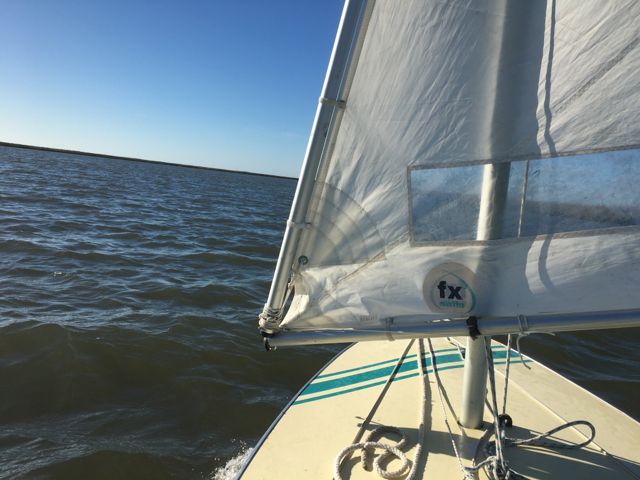 Once in the ferry passage, and sailing to windward through narrower creeks, I heard a boat motor to windward, and passed a CRNWR craft heading back to shore. We came up to close hauled again with a last long windward stretch in Bull Creek. The ENE wind, opposed to the strong outgoing tide, created a steep and bunched together chop. Kingfisher banged through these waves, occasionally dipping the bow under, and showering me with a splash-in-the-face. I tacked from shore to shore, not risking going aground, and coming about conservatively in these conditions. I was pleased to finally bear off and run down Summerhouse Creek for the landing at the island’s vacant public dock.
Once in the ferry passage, and sailing to windward through narrower creeks, I heard a boat motor to windward, and passed a CRNWR craft heading back to shore. We came up to close hauled again with a last long windward stretch in Bull Creek. The ENE wind, opposed to the strong outgoing tide, created a steep and bunched together chop. Kingfisher banged through these waves, occasionally dipping the bow under, and showering me with a splash-in-the-face. I tacked from shore to shore, not risking going aground, and coming about conservatively in these conditions. I was pleased to finally bear off and run down Summerhouse Creek for the landing at the island’s vacant public dock.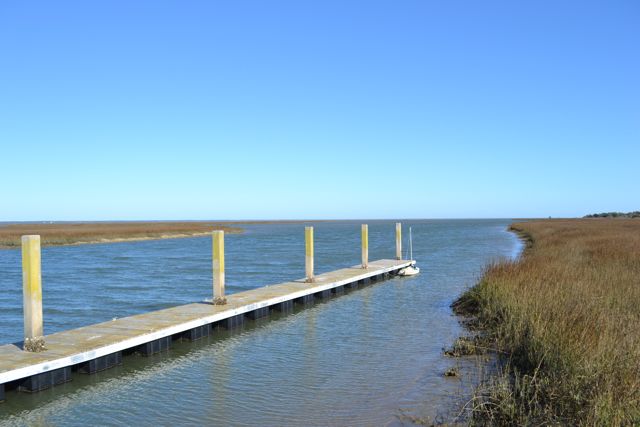
After tying up Kingfisher and securing sailing gear, I began an island walkaround. The canopy’s dominant loblolly pines whistled with the east winds. The Summerhouse Road took me to the Summerhouse Dike, and encounters with a few basking alligators as I headed toward the east.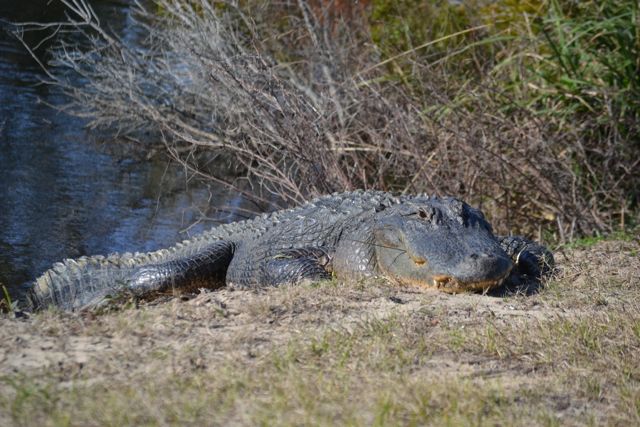 The entrance to the Turkey Walk Trail plunged me into a pine straw carpeted path through the rich maritime forest. The walk was different than my last walk through here in April – the trail in places was soggy, and there was an absence of mosquitoes. The wind’s whistle in the pines was gradually being replaced with surf sound. The thirty year recovery from Hurricane Hugo was evident in the forest’s lushness.
The entrance to the Turkey Walk Trail plunged me into a pine straw carpeted path through the rich maritime forest. The walk was different than my last walk through here in April – the trail in places was soggy, and there was an absence of mosquitoes. The wind’s whistle in the pines was gradually being replaced with surf sound. The thirty year recovery from Hurricane Hugo was evident in the forest’s lushness.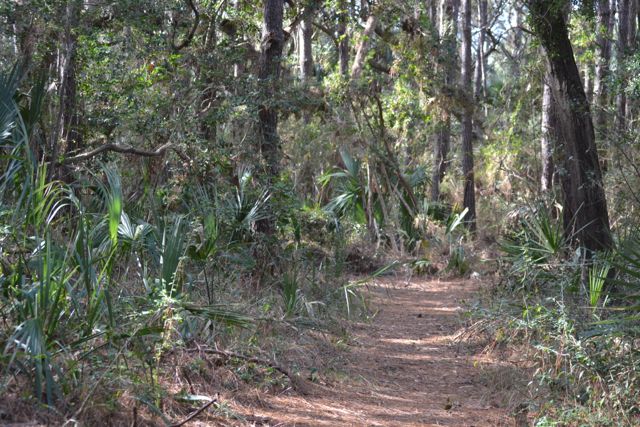
At the trail’s end and junction with the Beach Road, I continued to the north on Lighthouse Road, and another half-mile before turning right on the extension of Big Pond Road to the beach. Sections of the island, particularly the sloughs between ridges (old beach dunes), were flooded. 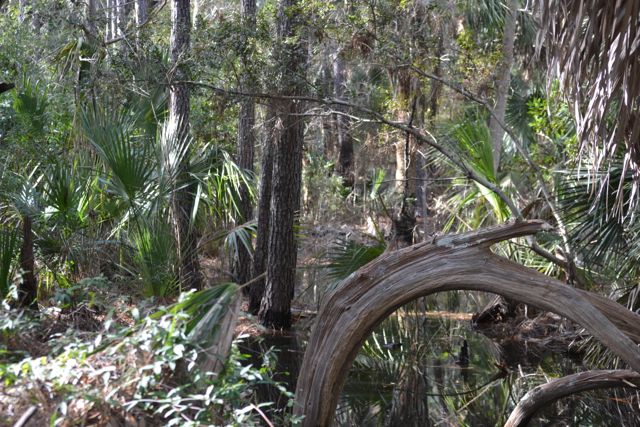 This ecosystem transitions from forest to shrub zone to dunes are always absorbing, and on this day the clear skies exposed a magnificent vista on the beach: views to the east toward the Boneyard, and southwest to Capers, Dewees, and Isle of Palms.
This ecosystem transitions from forest to shrub zone to dunes are always absorbing, and on this day the clear skies exposed a magnificent vista on the beach: views to the east toward the Boneyard, and southwest to Capers, Dewees, and Isle of Palms.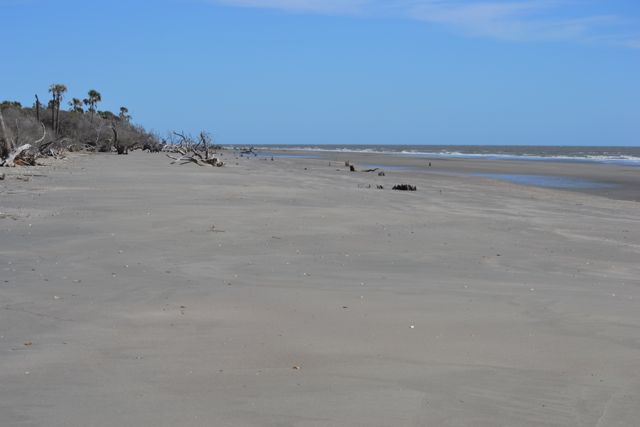
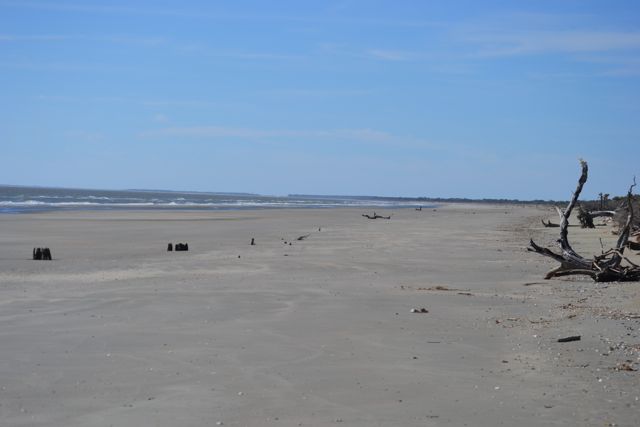
Walking to the east, the extension of the Boneyard spread all along, and erosion toppled more trees and left the root structures of some pines exposed. Entering the Boneyard’s curve to the northeast, I anticipating seeing further changes along this dynamic section of the island, and particularly the zone nearest to Moccasin Pond. This large cove was greatly widened along the beach front, and littered with more palmetto hulks.
Entering the Boneyard’s curve to the northeast, I anticipating seeing further changes along this dynamic section of the island, and particularly the zone nearest to Moccasin Pond. This large cove was greatly widened along the beach front, and littered with more palmetto hulks.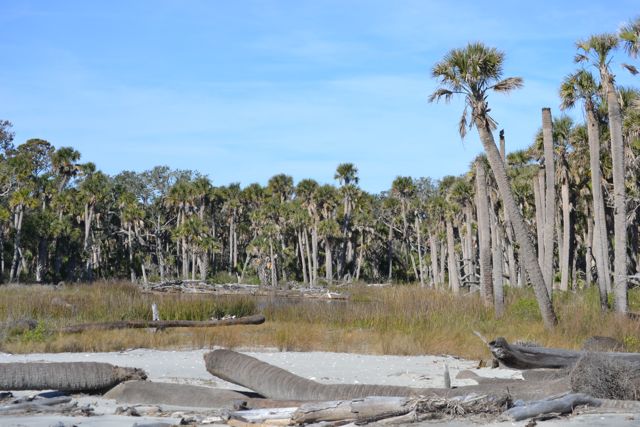 At the south end of this feature, vultures were feasting on a carcass. Walking in to investigate, the vultures gave way, and the carcass initially did not stand out from the palmettos. Closer inspection revealed it as a small bottlenose dolphin, still fairly intact despite the vultures’ feeding.
At the south end of this feature, vultures were feasting on a carcass. Walking in to investigate, the vultures gave way, and the carcass initially did not stand out from the palmettos. Closer inspection revealed it as a small bottlenose dolphin, still fairly intact despite the vultures’ feeding.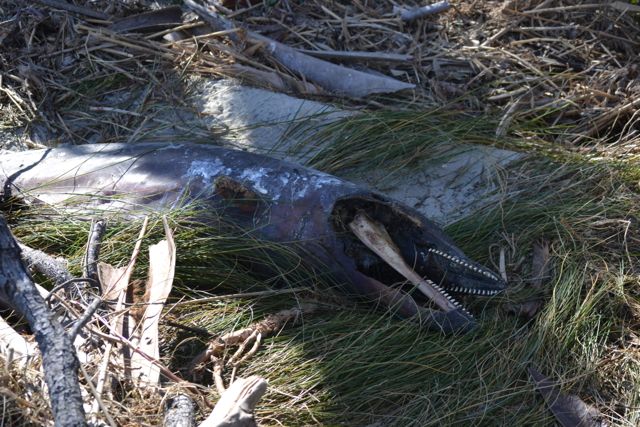
I hopped on to the dike and trail connecting to the road system, and estimated the remaining raised walkway’s length was maybe one third what it was in 2005. My walk to connect with the Lighthouse Road was thwarted by a Closed Area sign. Not understanding the reason for this posting, but deciding on compliance, I backtracked to the Boneyard, and continued around to the cut off dike on the north side. Again, the amount of erosion was staggering since my last viewing – the old dike infrastructure more nakedly exposed than ever.
Crossing the small tidal creek cutting through the beach from the breached New Pond, I climbed up the end of the dike and walked to the levee crossing Jack’s Creek to continue my walkaround. I was glad to see there were no Closed Area signs, and made my way along this causeway. Rafts of waterfowl lifted off and returned to the impoundment, and wading birds probed the shallows.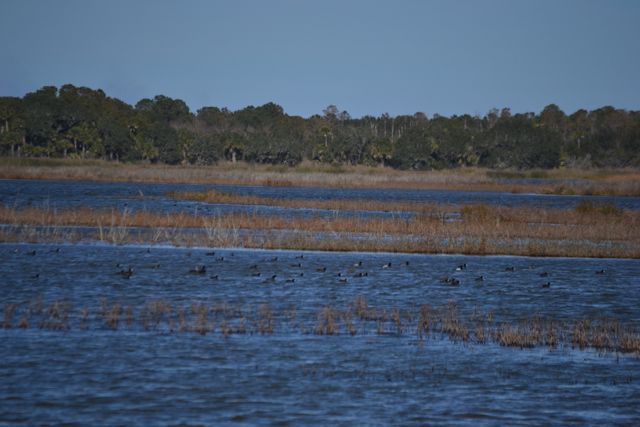
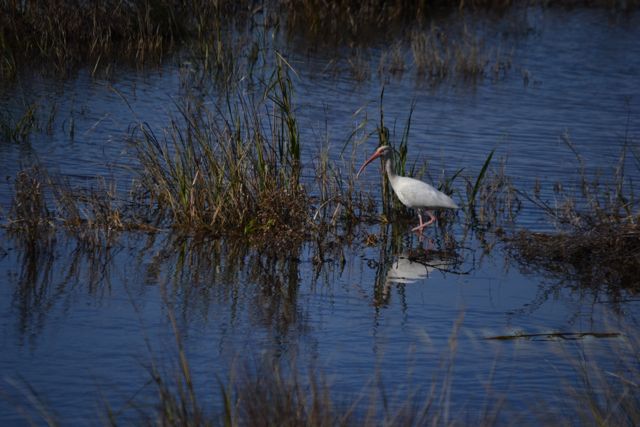 In the distance, the “T” junction appeared to have deep furrows along it, but on the approach these furrows were in fact dozens of basking alligators. It was an impressive gathering; most gave way and slithered down into the water, yet a few held their ground as I walked past.
In the distance, the “T” junction appeared to have deep furrows along it, but on the approach these furrows were in fact dozens of basking alligators. It was an impressive gathering; most gave way and slithered down into the water, yet a few held their ground as I walked past.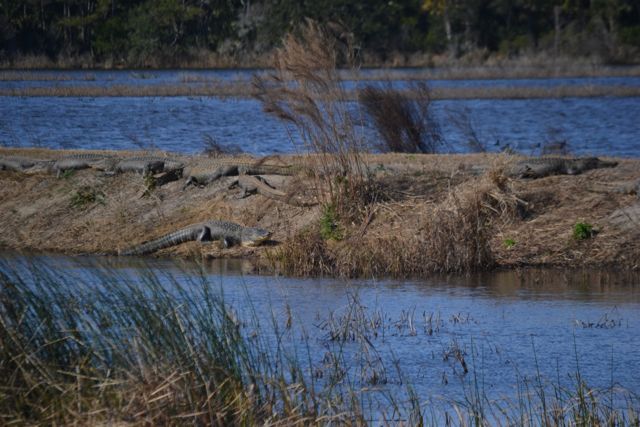 I was reminded of William Bartram’s frightening interactions with massive alligators in Florida in the 1770’s.
I was reminded of William Bartram’s frightening interactions with massive alligators in Florida in the 1770’s.
The dike connects to the road system at the observation tower, and it was another twenty-five minutes to the dock. As I began preparations for the return sail, to be facilitated by a lively breeze, I had company. An outboard came by with fishermen to try their luck around the refuge’s landing wall, and a pod of dolphins were collectively fishing along the adjacent oyster bank. The powerful bodies of these bottlenose dolphins thrashed the shallow waters in close proximity.
I was aware upon setting sail that even though the tide was rising it was shallower than on my earlier sail. Despite my precautions, I still managed to run aground with my daggerboard, but did not repeat my September mishap. As I bore off into Bull Creek I found myself suddenly planing and even surfing on some waves, and waited to the relative calm of the lee of a marsh island to head up into the wind and make some rig adjustments. That done, I bore off again to run down the creek and continue in the ferry route. The course changed until I again was closehauled and making way against the incoming tide. Though opposed by wind and tide, progress was good in the relatively smooth waters, and we finally joined with the tide and wind in the reach into Andersonville Creek toward the ICW.
The waters of the ICW were roiled by the solid ENE wind now opposed by the incoming tide. It would be no gentle landing, but after dropping sail well to windward of the dock I coasted in. My attempt to paddle Kingfisher up on to the trailer with the strong crosswind was not successful, and rubbing on to oyster covered pilings, I surrendered and dropped into the knee deep waters to manually load the hull. No rest for the weary.
19 thoughts on “A sail into solitude”
Comments are closed.
Beautiful photos except the one of poor little dolphin-hard to look at. You’re aging well, Bob!
Well done, Bob. Good to see you back on board and back ashore on Bulls. the sights look some familiar as I’ve taken the ferry four times in the last year. but not all familiar. Sad for the porpoise. Keep it up. b
Sorry I’ve missed you out there. Yes, trying to get back on board.
envious!
thanks!
Thanks for taking us along for the ride, Dad. Looks like a peaceful day on the island to enjoy some solitude and reflection. I’m feeling the pull!!
Yes, it would be good to get the Painters out there before it gets warm.
Great pictures and text Bob. You’re very brave to get so close to the alligators like that. That row of gators looks like Merritt Island Preserve. Enjoyed your blog.
Thanks, Linda. No, not brave, just careful, keep my distance (longer lens), and am respectful of these powerful animals.
Bob, happy 2020. I’m planning a Bull Island trip in late Feb/early March. From your description, I’m going to see a lot of erosion damage since my last trip in 2017. Great observations, and great writing as always.
That will be a good time to get out there. You will see the island’s dynamics on full display. The cross dike over Jack’s Creek has opened up a number of loop hikes not available in the past, and if you can plan that it will be worth it.
Another wonderful viewing through your pen and lens! Thank you!! I have said for a long time that I want to kayak out to the island for a full day of exploring in the winter months. Your post certainly reminds me of why that is a worthy trip to plan!
Make those plans, Scott. Winter is a great time as long as you don’t go for a swim.
Just the paddle there and back is worth the trip. Utilize the tides so you can save some energy for a hike.
Bob,
Happy to see you’re back in the saddle and enjoying the beauty and magic of that wonderful place.
I received the recent “Friends of Coastal South Carolina” newsletter and read a record number of loggerhead sea turtle nests in the CRNWR for 2019 of 3,546!
Thanks Bob and keep up the great work and enjoyment.
CU all in June!
It was quite a year for loggerheads. Conservation efforts all along the coast have contributed to this recovery. We will see what 2020 brings.
What a great ride to Bull Island. Thanks for taking us along and reminding us of the beauty and awesomeness we live in.
You are smart, brave and strong! Keep it up!?
Truly inspirational to get outside and explore!
Thanks Superman! Hope you are continuing to save the world.
Raynor – you’re one tough hombre and a great photog-writer. Congrats on getting back on the horse! I don’t know if all of your readers know what a challenging body of water Bull’s bay is but sailing that area in a sunfish is about the hardest (and coolest ;)) ways to travel those waters. I know how to sail but I have only done bulls in a small outboard.
Once upon a time I might have been a tad hardcore, but a bit slower and softer now. Kingfisher and I still have a good understanding, though seek less extreme conditions these days.